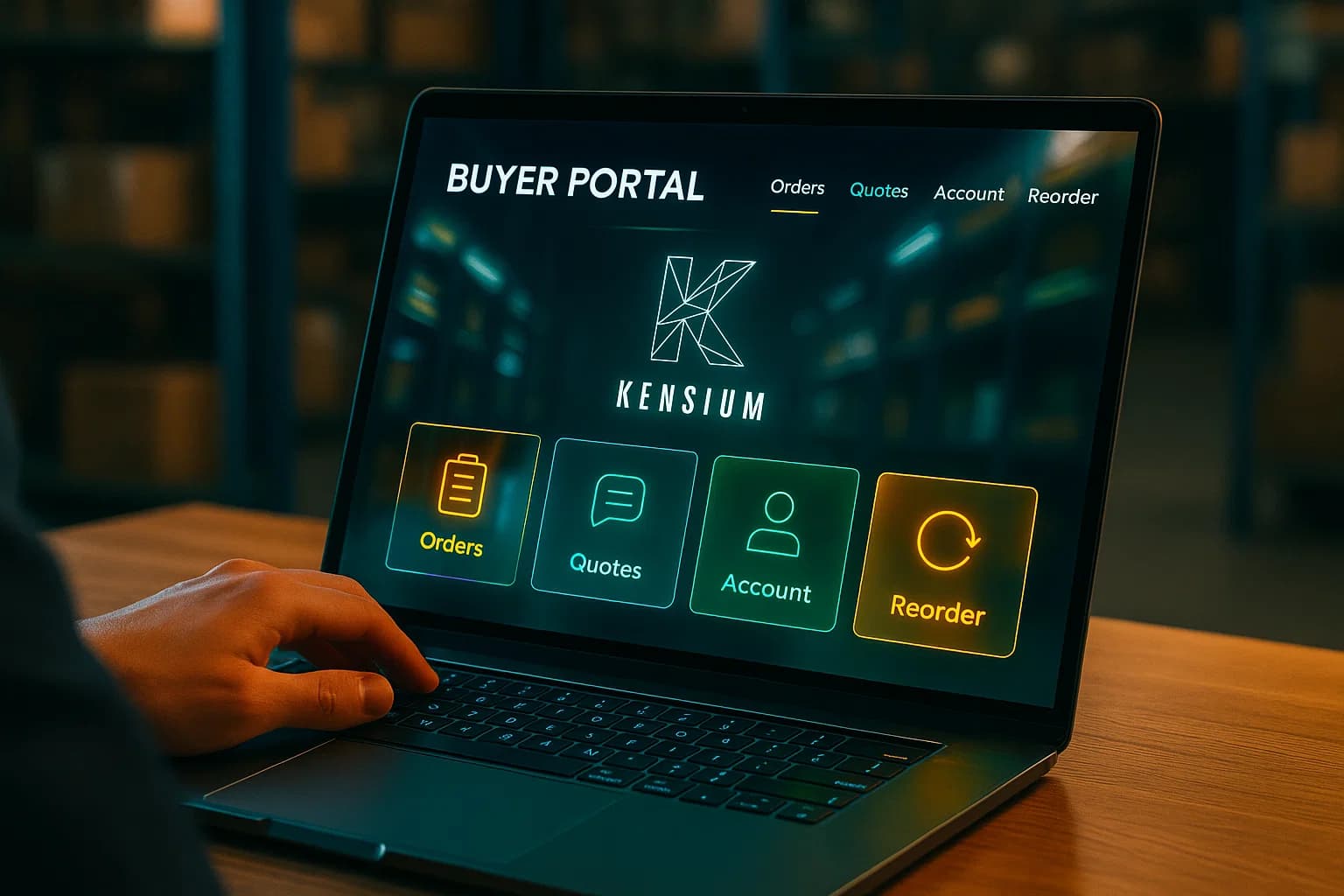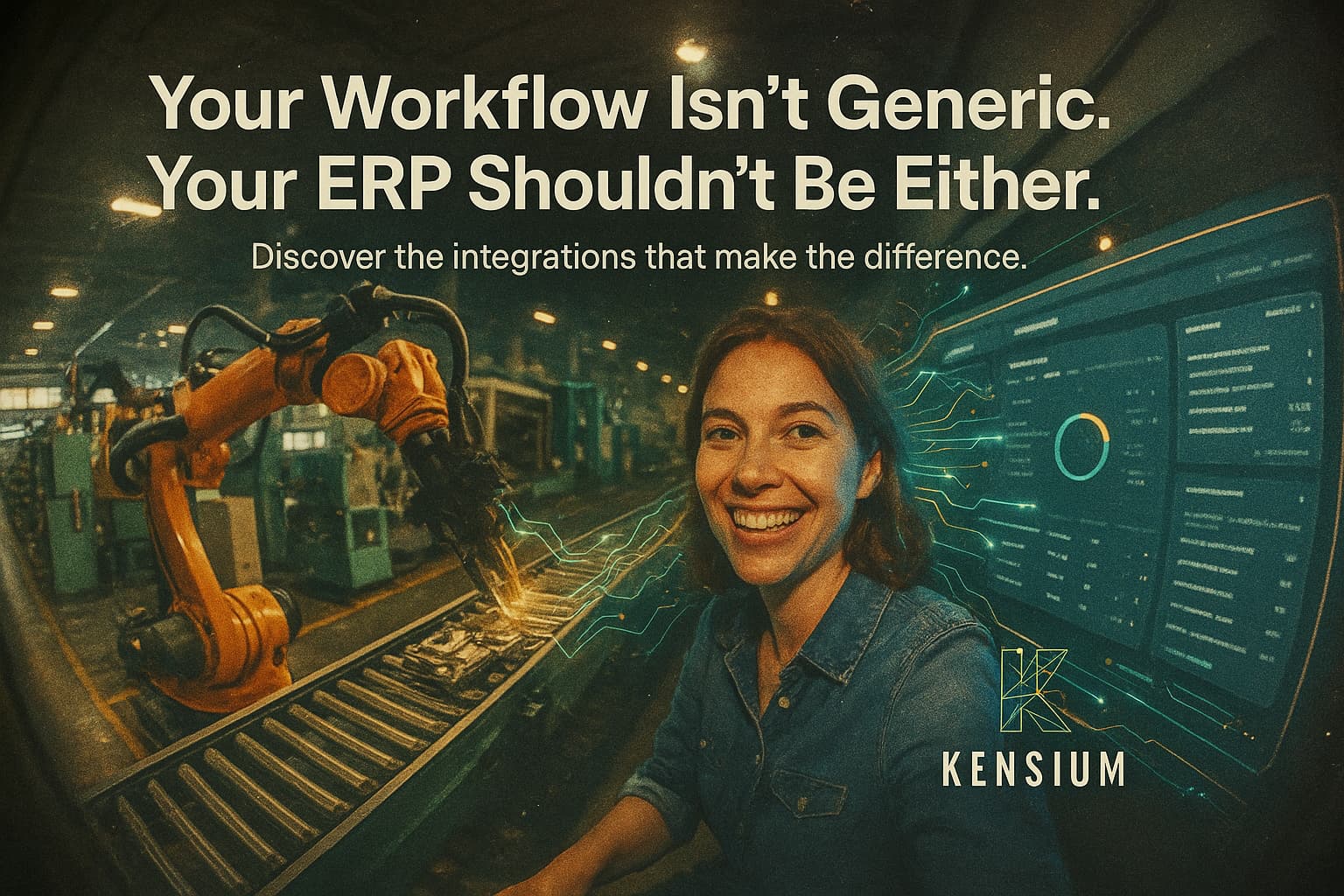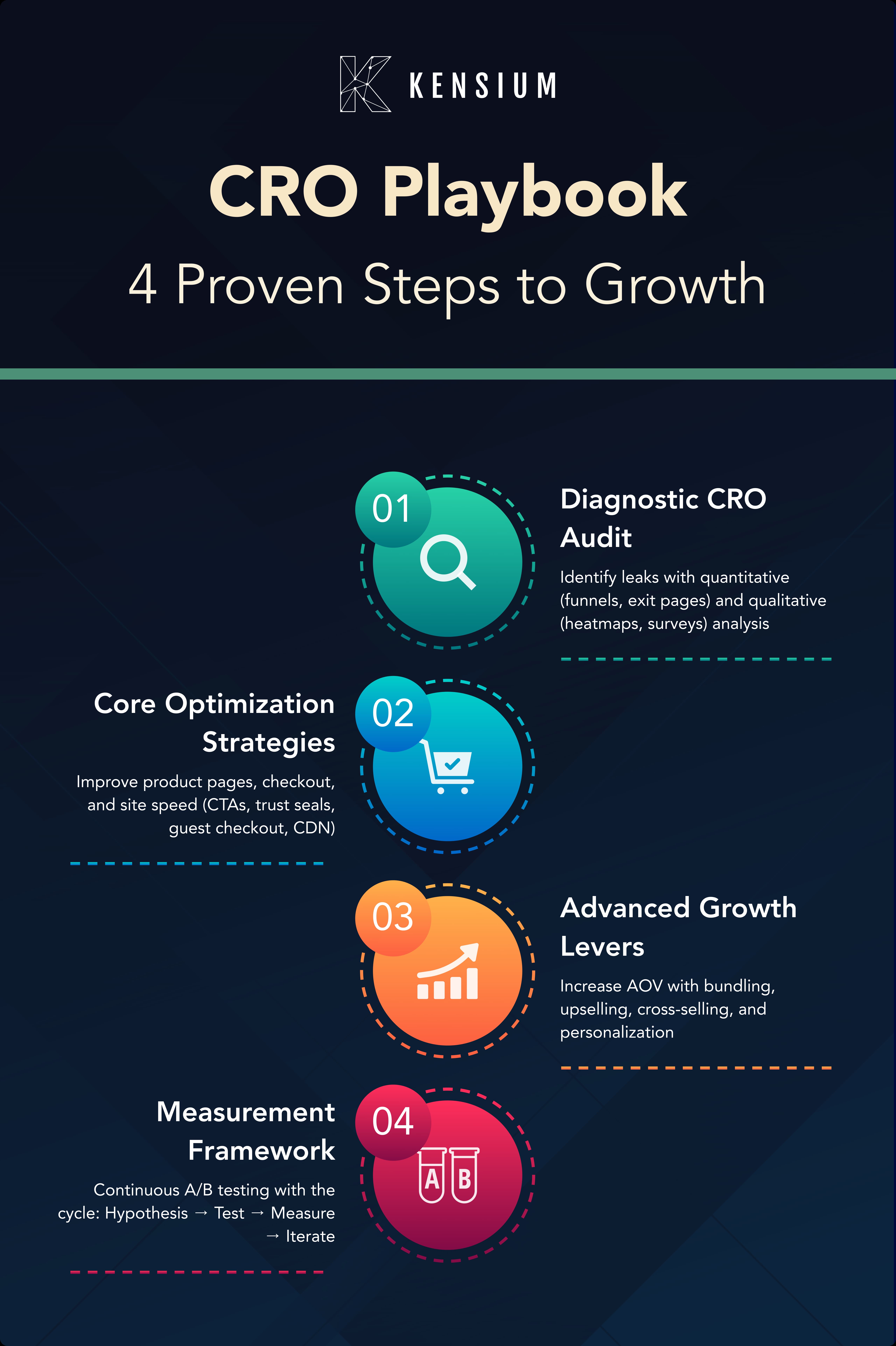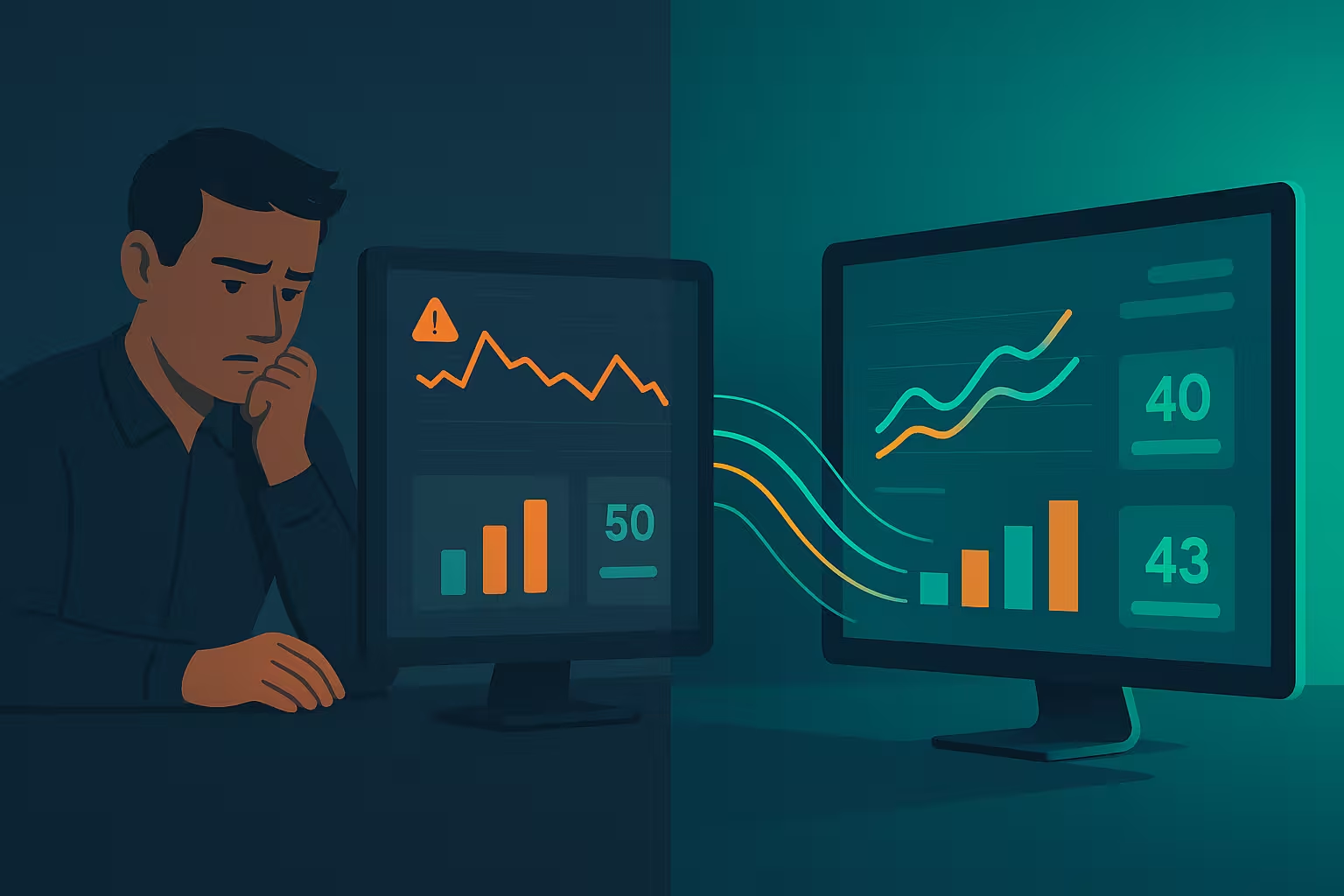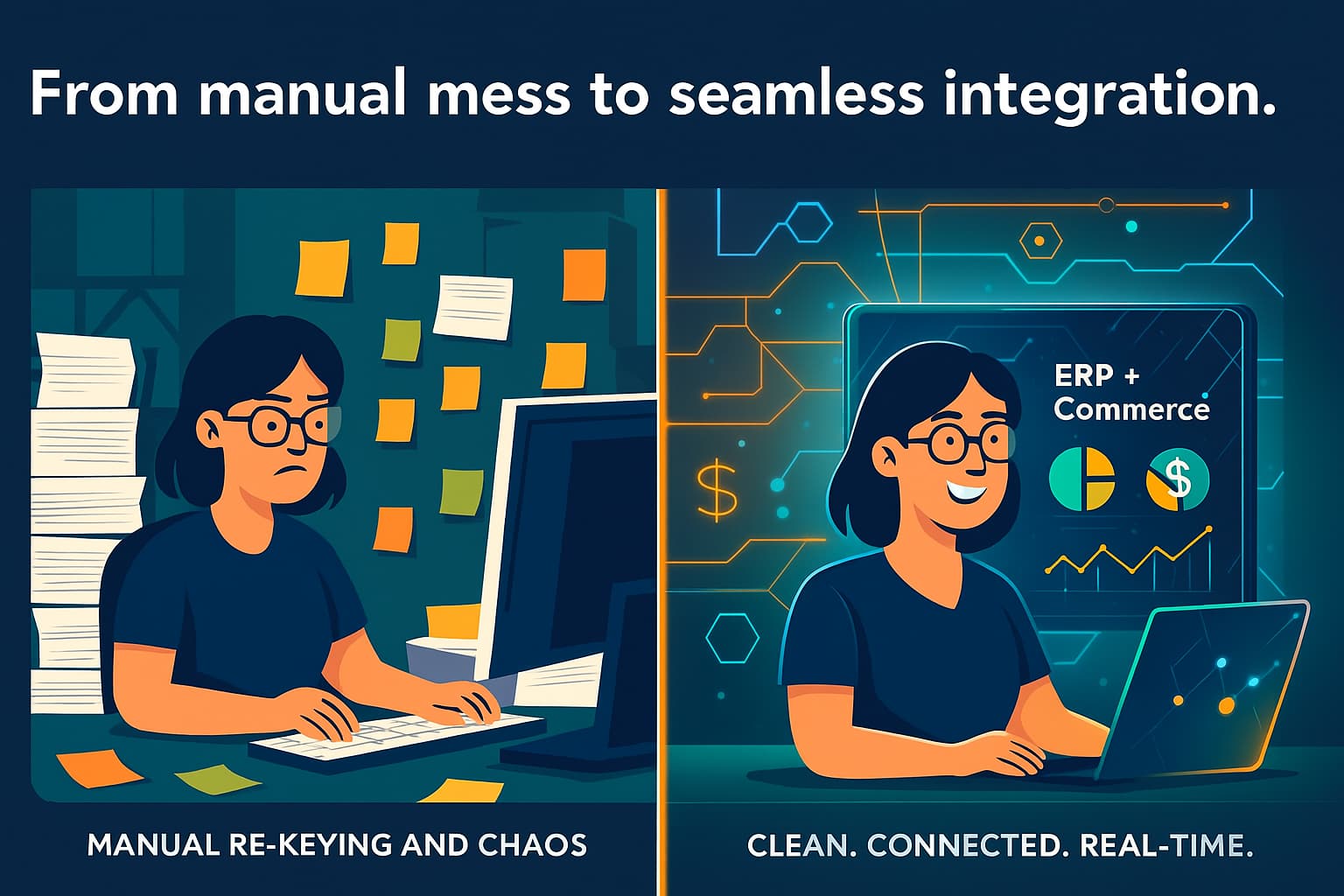
Introduction: Distribution businesses thrive on efficiency and accuracy. Yet many distributors run their eCommerce sales channel and back-end ERP in isolation, leading to manual work and costly errors. An ERP–eCommerce integration connects your online store with your enterprise systems in real time, eliminating data silos and automating workflows. How do you know it’s time to make this move? Here are the top five signs – presented as a checklist of pain points – that your distribution business needs ERP–eCommerce integration (each backed by real-world quotes), and how integration solves each issue.
1. Manual Order Entry Is Draining Your Team’s Time and Energy
If your staff spend hours re-keying orders from emails, spreadsheets, or separate portals into your ERP, that’s a glaring red flag. Not only is this repetitive work inefficient, but it also inevitably leads to mistakes. One supply chain professional observed the issue firsthand at food distributors:
“Orders come in through email, WhatsApp, text, even phone calls. Then someone has to sit there and retype everything into the ERP. It’s slow, people make mistakes, and it's just a lot of repetitive admin work. It feels like half the ops team is doing copy-paste work all day instead of actually managing operations.”[1]
How integration helps: By connecting your eCommerce platform and ERP, orders flow automatically from the online store into the ERP system – no more manual re-entry. Integration eliminates the copy-paste drudgery and typos, so your team can focus on managing operations and customer service instead of data entry. For example, orders placed on your website can instantly create sales orders in your ERP for picking and shipping, without human intervention. This automation improves order accuracy and processing speed. In short, an integrated solution (like the ones Kensium’s Enterprise Integrations provide) ensures you’re not paying employees to do the same work twice.
2. Inventory Surprises: Overselling and Stockouts Are Happening
Another telltale sign is when your inventory information isn’t in sync between systems. Perhaps your website shows items in stock that aren’t actually available, leading to backorders or upset customers. Overselling – taking more orders than you have inventory – is a distribution business’s nightmare. One Shopify merchant shared a painful overselling episode:
“Last Black Friday was a nightmare with overselling products because Shopify's inventory didn't sync fast enough with other channels... the sync delay meant we oversold by 30 units on Shopify alone. Spent the entire weekend calling customers to cancel orders. Lost probably 15k in sales plus damaged reputation from angry customers.”[2]
It’s not just small losses at stake – stockouts and overselling cost retailers an estimated $1 trillion each year[3] in lost revenue and damage to customer loyalty. In many cases, these problems arise because your online store and ERP aren’t updating inventory in real time. As Shopify’s own retail guide warns, “A lack of real-time inventory updates can lead to overselling”[4].
How integration helps: ERP–eCommerce integration keeps inventory counts accurate across all channels. The moment a product is sold or received, stock levels update everywhere – on your website, marketplaces, and in the ERP. This means customers won’t be able to buy something that’s out of stock, and you avoid the overselling fiasco entirely. Real-time sync between your ERP and eCommerce ensures that if an item is running low, your site reflects it or even marks it sold-out, preventing orders you can’t fulfill. Integration also enables features like safety stock thresholds and automatic alerts, so your distribution business can maintain optimal inventory and fulfill demand without disappointing customers.
3. Order Fulfillment Is Slow and Error-Prone
Do orders sometimes fall through the cracks or ship late because your systems aren’t connected? Perhaps your team prints out online orders and then manually creates pick tickets or shipping labels in the ERP or warehouse system. These extra steps slow down fulfillment and introduce errors (wrong items, addresses, etc.). In one case study, a distributor that lost its eCommerce–ERP integration had to revert to manual processes – with dire consequences:
After losing their integration, orders, inventory, and pricing updates were handled outside the system, creating “errors, wasted labor, and unreliable inventory during their busiest season.”[5]
When your systems don’t “talk” to each other, your staff must act as the go-between, which often can’t keep up with order volume. Mistakes like shipping the wrong product or delays in updating order status can erode customer satisfaction.
How integration helps: An integrated eCommerce and ERP setup automates the order fulfillment workflow. The instant an online order is placed, it appears in the ERP or Order Management module ready for picking, packing, and shipping. No waiting for someone to manually export or re-key it. This speeds up processing times (customers get their packages faster) and slashes the error rate. As operations experts note, integrating systems means faster shipping and fewer mistakes since data flows through automatically. In fact, businesses report that when their eCommerce and ERP are linked, orders go straight into one system for fulfillment – resulting in quicker turnarounds and far less manual work[6]. The outcome is a smoother fulfilment process, where your team can ship more orders in less time, with confidence that nothing was overlooked or entered incorrectly.
4. Data Is Scattered in Silos and Causing Duplicate Work
Do you maintain separate records for products, customers, and orders in different systems that never quite match up? Perhaps pricing updates have to be entered in both the ERP and the eCommerce platform, or your sales reports require merging data from multiple sources. Siloed data not only wastes time but leads to inconsistencies (e.g. the online store showing a different price or description than your ERP). If your staff joke that Excel is your “integration” tool, it’s a serious sign of trouble.
One Reddit user explained how proper integration fixes this by unifying data into a single source of truth instead of disconnected silos:
“If you’re selling across multiple channels or managing 1k+ SKUs, ERP integration pays off by pushing real-time stock and prices to your store and pulling confirmed orders straight into pick/pack/ship and finance — no copy-paste... Because inventory, orders, and invoices live in one place, your sales reports line up without reconciling spreadsheets.”[7]
How integration helps: By connecting your systems, you centralize your data. Product details, inventory levels, order status, customer info – all of it becomes consistent across the board. Update something in the ERP and it automatically updates on the website (and vice versa for web orders). This eliminates duplicate data entry and the dreaded task of comparing spreadsheets to figure out the “real” numbers. An ERP–eCommerce integration essentially removes data silos, ensuring everyone from sales to warehouse to accounting is working off the same real-time information. The result is not only saved labor, but also better decision-making – you can trust your reports and dashboards because they’re pulling from a unified database. In short, integration gives you one version of the truth for your distribution business, instead of many fragmented ones.
5. You’re Struggling to Scale (Growth Creates Chaos)
Finally, consider what happens as your business grows. Can your current processes handle double the orders or new sales channels? If adding volume makes your operations chaotic – more mistakes, slower turnaround, constant firefighting – that’s a strong sign you need integration to scale up smoothly. As one discussion noted, relying on patched-together manual systems becomes riskier with growth:
“True, but as volume and complexity grow, manual systems increase risk. Even basic automation struggles to scale once cross-warehouse coordination is needed.”[8]
Many distributors start with workarounds that function at a small scale (like keying orders by hand or using separate software for each warehouse). However, those don’t translate when your order count jumps or you expand to multiple locations/channels. The business may hit a ceiling because the overhead of managing disconnected systems eats up all your time, or errors multiply to the point of harming your reputation.
How integration helps: ERP–eCommerce integration is a foundation for scalable growth. It equips you to handle higher order volumes and complexity without a corresponding spike in labor or errors. By automating processes (from order import to inventory updates to financial entries), you can grow revenue while actually reducing operational headaches. Integration also makes it easier to add new eCommerce channels or marketplaces since your central ERP will keep everything synchronized. In essence, it shifts you from constantly putting out fires to a more proactive, growth-ready operation. Many businesses in this position turn to solutions like Kensium’s integration services – which offer pre-built connectors for platforms like Shopify, BigCommerce, and Adobe Commerce – to quickly connect their systems and future-proof their expansion[9].
Conclusion: The Signs Are Clear — What’s Next?
If you nodded “yes” to several of these signs — manual data entry, inventory oversells, process delays, fragmented data, or struggles in scaling — it’s likely time to integrate your eCommerce storefront with your ERP. The cost of doing nothing is continued inefficiency, lost sales, and stunted growth. On the flip side, a well-executed integration solves these pain points: orders flow seamlessly, inventory is always up to date, customers stay happy, and your team can devote energy to strategic activities rather than grunt work.
For distribution companies, an ERP–eCommerce integration isn’t just an IT project — it’s a strategic move to build a more resilient and agile business. Kensium specializes in making this integration journey smooth, handling the heavy lifting of connecting systems so you can focus on growing your distribution empire.
Don’t let outdated processes hold you back. By checking off this “to-do” (integrating your systems), you position your business to fulfill orders faster, keep customers satisfied, and scale to new heights without the growing pains. The signs are telling you it’s time — and the solution is within reach.
👉 Learn more about Kensium’s ERP–Ecommerce Integration Services
Sources: The insights and quotes above are drawn from real merchant experiences on Reddit and expert eCommerce resources. These include discussions in supply chain and eCommerce forums, official Shopify retail reports on overselling, an Adobe Commerce integration overview, as well as Kensium’s own case studies and blog posts on ERP–eCommerce integration[1][2][3][5][7][8]. Each source reinforces the critical role of integration in eliminating manual pain points and enabling growth. By heeding these signs and leveraging integration, your distribution business can operate with the efficiency and accuracy of a well-oiled machine.
[1] Anyone find a way to cut down on all the manual order entry from email/WhatsApp/etc? : r/supplychain
[2] How do you prevent inventory sync disasters during peak season? : r/shopify
https://www.reddit.com/r/shopify/comments/1n9oplg/how_do_you_prevent_inventory_sync_disasters/
[3] [4] What is Overselling and How to Prevent It (2022) - Shopify
https://www.shopify.com/retail/overselling
[5] [9] Scaling Up Your Small Business for E-Commerce Growth
https://www.kensium.com/blog/scaling-up-your-small-business-for-ecommerce-growth
[6] [7] What are the benefits of integrating an ERP system with my eCommerce store? : r/ERP
https://www.reddit.com/r/ERP/comments/1npaewm/what_are_the_benefits_of_integrating_an_erp/
[8] How do you know when it’s ERP time? : r/shopify
https://www.reddit.com/r/shopify/comments/1n84q7r/how_do_you_know_when_its_erp_time/
[10] Accelerating back-office integrations for Adobe Commerce.
https://business.adobe.com/blog/accelerating-back-office-integrations-for-adobe-commerce








.png)



